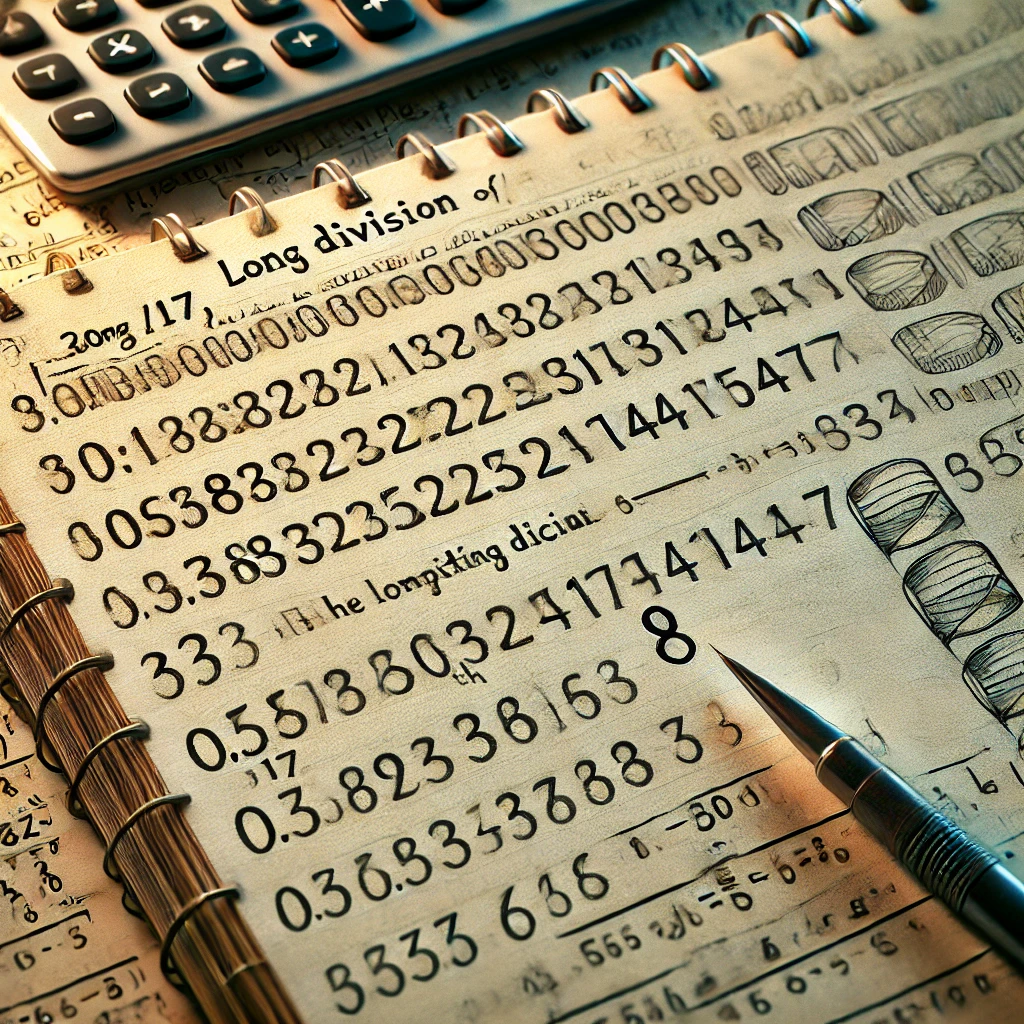Introduction: The Enigma of Repeating Decimals
Repeating decimals captivate mathematicians and students alike due to their cyclical nature and the patterns they reveal in numerical relationships. A classic example is the decimal representation of fractions like 1/17, which results in an intriguing repeating sequence. This article will explore the decimal 0.0588235294117647, focusing on understanding its origins, calculating its digits, and appreciating its mathematical beauty.
The Origin of What is the 300th digit of 0.0588235294117647: A Fractional Perspective
Understanding 1/17
The decimal 0.0588235294117647 is the result of dividing 1 by 17. This fraction, when expressed in decimal form, reveals a repeating cycle. To fully appreciate the complexity and the beauty of this decimal, we first need to explore its repeating nature and how it emerges from basic arithmetic operations.
The Repeating Nature of 1/17
When you divide 1 by 17 using long division, the result is a repeating decimal that cycles every 16 digits. This sequence, 0.0588235294117647, repeats indefinitely. The repetition occurs because the remainders in the division process begin to repeat after a certain point, leading to the recurrence of the same sequence of digits.
How to Easily Calculate the 300th Digit of 0.0588235294117647
Step-by-Step Calculation Guide
Calculating the 300th digit of a repeating decimal like 0.0588235294117647 is surprisingly straightforward once you understand the pattern:
- Identify the Length of the Repeating Cycle: For 1/17, the cycle length is 16 digits.
- Calculate the Position Within the Cycle: The 300th position corresponds to 300mod 16300 \mod 16300mod16. If we compute this, we find that 300 divided by 16 leaves a remainder of 4. This means the 300th digit is the 4th digit in the repeating sequence.
- Determine the Digit: Look at the 4th digit of the sequence
0.0588235294117647, which is ‘8’.
Practical Applications of Calculating the 300th Digit of 0.0588235294117647
Understanding how to What is the 300th digit of 0.0588235294117647 pinpoint a specific digit in a repeating decimal sequence has diverse practical applications, particularly in the fields of computer science and cryptography. Such calculations can help in algorithm design where precision and predictability of cyclic patterns are crucial for data encryption and security protocols. In numerical analysis, determining precise digits in lengthy decimal expansions aids in the accuracy of computational models and simulations. This mathematical skill enhances error checking in software development, where exact values are needed to maintain the integrity and functionality of applications. Essentially, the ability to dissect and manipulate numeric sequences refines the precision and efficiency of technological systems and scientific computations.
Exploring Similar Fractions: The Decimal Representations of Other Seventeenths
Without performing the long division, here’s how the decimal expansions for other fractions of 17 appear:
- 2/17: Multiply the sequence of 1/17 by 2. Each digit in
0.0588235294117647multiplied by 2 gives the decimal0.1176470588235294. - 3/17: Similarly, multiplying each digit of 1/17 by 3 results in
0.1764705882352941. - 5/17: Multiplying by 5,
0.2941176470588235. - 10/17: Doubling the sequence of 5/17 results in
0.5882352941176471.
Each of these results is a simple scalar multiplication of the repeating sequence of 1/17, showcasing the fascinating properties of fractions and their decimal expansions.
Why Is the Number 1/17 Special?
1/17 stands out due to its relatively long cycle length of 16 digits. Most fractions do not yield such lengthy repeating sequences, making 1/17 a prime candidate for studies in periodicity and sequence analysis in mathematical theory.
Conclusion: The Significance of the 300th Digit
In mathematics, seemingly trivial tasks like finding the 300th digit of a decimal can unravel profound insights into number theory, reveal underlying patterns, and enhance our understanding of numerical properties. The study of such decimals not only enriches academic knowledge but also has practical applications in technology and science, demonstrating the timeless relevance of fundamental mathematical exploration.
FAQs on Calculating the 300th Digit of 0.0588235294117647
Q1: What is the 300th digit of the decimal 0.0588235294117647?
A1: The 300th digit of 0.0588235294117647 is ‘8’.
Q2: How is the 300th digit of 0.0588235294117647 determined?
A2: Since 0.0588235294117647 repeats every 16 digits, you find the 300th digit by calculating 300mod 16300 \mod 16300mod16, which results in 4, making the 4th digit in the sequence, which is ‘8’, the 300th digit.
Q3: Why is it important to calculate specific digits in decimal expansions?
A3: Calculating specific digits can be essential in fields like cryptography for encryption algorithms, in computer science for software accuracy, and in numerical analysis for modeling precision.
Q4: Can this method be used for other repeating decimals?
A4: Yes, this method can be applied to any repeating decimal. You just need to know the length of the repeating cycle and the position of the digit you are interested in.


